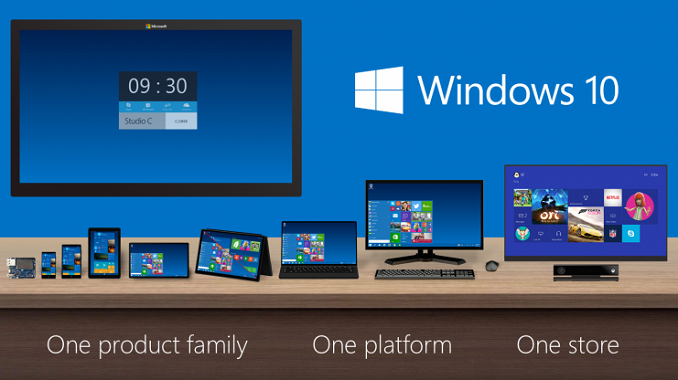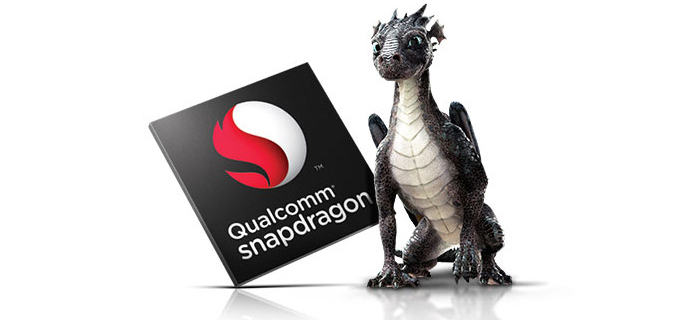Microsoft and Qualcomm Collaborate to Bring Windows 10 & x86 Emulation to Snapdragon Processors
by Matt Humrick & Brett Howse on December 7, 2016 10:00 PM EST- Posted in
- Microsoft
- Snapdragon
- Qualcomm
- Windows 10

Today at Microsoft’s WinHEC event in Shenzhen, China, the company announced that it’s working with Qualcomm to bring the full Windows 10 experience to future devices powered by Snapdragon processors. Terry Myerson, executive vice president of the Windows and Devices Group at Microsoft, is “excited to bring Windows 10 to the ARM ecosystem” and looks forward to bringing “Windows 10 to life with a range of thin, light, power-efficient and always-connected devices,” which may include anything from smartphones to tablets to ultraportable laptops to servers. These new Snapdragon-powered devices should support all things Microsoft, including Microsoft Office, Windows Hello, Windows Pen, and the Edge browser, alongside third-party Universal Windows Platform (UWP) apps and, most interestingly, x86 (32-bit) Win32 apps. They should even be able to play Crysis 2.
This announcement fits nicely with Microsoft’s “Windows Everywhere” doctrine and should come as no surprise. It’s not even the first time we’ve seen Windows running on ARM processors. Microsoft’s failed Windows RT operating system was a modified version of Windows 8 that targeted the ARMv7-A 32-bit architecture. It grew from Microsoft’s MinWin effort to make Windows more modular by reorganizing the operating system and cleaning up API dependencies.
This work first surfaced in Windows Server 2008, which could be installed with a stripped-down, command-line only interface that did not include components such as Internet Explorer that were not necessary for specific server roles. Windows RT also leveraged the newer Windows Runtime (WinRT) API that offered several new features such as digitally signed app packages distributed through the centralized Windows Store and the ability to run apps within a sandbox. It also made it easier for software developers to target multiple CPU architectures. However, Microsoft’s rework of Windows was not yet complete, leaving Windows RT with a bunch of legacy Win32 code that went unused. It also could not run Win32 desktop apps, severely limiting the number of available apps to only those using WinRT and distributed through the Windows Store.
MinWin and its derivatives have continued to evolve over the past few years after getting a major boost in 2013 when Microsoft reorganized its disparate software platforms into the singular Operating Systems Engineering Group. The end result is Windows 10, a modular OS that can run on anything from low-powered IoT devices to high-performing workstations and servers. Its foundation is OneCore, MinWin’s direct descendant, that includes only the operating system kernel and components essential for any hardware platform. OneCore UAP (Universal App Platform) is another major module for Windows 10 whose groundwork was laid during the creation of Windows Phone and Windows RT. It provides support for Universal Windows Apps and Drivers, along with more advanced features such as the Edge browser and DirectX. On top of these modules, Microsoft can add modules that target specific device families (desktop, mobile, Xbox, HoloLens, etc.) that provide specialized features and shells.
Also included in OneCore UAP is Universal Windows Platform (UWP). An extension of the WinRT API used in Windows 8, it allows developers to create universal apps that are CPU architecture agnostic and can run on multiple devices, seamlessly adapting their user interface and input methods to the hardware they’re running on. With UWP, the architecutre independence is achieved by having pre-compiled versions for each platform available from the Store, which will then download and install the correct version for the individual device. The major change with today's announcement over Windows RT and UWP is that x86 apps will be able to run on Qualcomm's ARM-based SoCs, along with support for all of the peripherals that are already supported with Windows 10. This alone is a huge change from Windows RT, which would only work with a small subset of peripherals.
Microsoft is also focusing on having these devices always connected through cellular, which is something that is not available for many PCs at the moment. Support will be available for eSIM to avoid having to find room in a cramped design to accomodate a physical SIM, and Microsoft is going so far as to call these "cellular PCs" meaning they are expecting broad support for this class of computer, rather than the handful available now with cellular connectivity.
The ability to run x86 Win32 apps on ARM will come through emulation, and to demonstrate the performance Microsoft has released a video of an ARM PC running Photoshop.
This of course raises several questions, few-if-any of which Microsoft is willing to answer. Intel has long exerted strong control over the x86 ISA, limiting or outright preventing competitors like NVIDIA from implementing x86 support. So how Microsoft and Qualcomm are able to (for lack of a better way to put it) get away with this is a big question. Certainly there's no indication right now that this has Intel's formal blessing.
The key points here are that this is a form of software emulation - Microsoft even calls it as much - and that only 32-bit x86 support is being offered. On the former, this means that there's no hardware execution of x86 instructions taking place - though Microsoft and Qualcomm are certainly lining up instructions as best they can - which avoids many of the obvious patent pitfalls of doing x86 in hardware, and puts it in the same category as other x86 emulation mechanisms like DOSBox and QEMU. Meanwhile only supporting 32-bit x86 code further rolls back the clock, as the most important of those instructions are by now quite old, x86 having made the jump to 64-bit x86-64 back in 2003. So it may very well be that it's easier to avoid any potential legal issues by sticking with 32-bit code, though that's supposition on our part. In any case it will be interesting to see what instructions Microsoft's emulator supports, and whether newer instructions and instruction set extensions (e.g SSE2) are supported in some fashion.
Of course, the performance of this solution remains to be seen. x86 is not easy or cheap to emulate, and an "emulator" as opposed to a Denver-like instruction translation makes that all the harder. On the other hand, while maximizing x86 compatibility is great for Microsoft and Qualcomm, what they really need x86 for is legacy applications, which broadly speaking aren't performance-critical. So while x86 on a phone/tablet ARM SoC may not be fast, it need only be "good enough."
In any case, Windows 10’s ability to scale and adapt to essentially any hardware platform is a remarkable feat of engineering, and it’s what makes today’s joint announcement with Qualcomm possible. The first devices with Snapdragon SoCs running the full Windows 10 experience should be available in the second half of 2017.
It will be interesting to see what shape these devices take and which companies produce them. Some new lower-cost, full-featured Windows 10 tablets would be a welcome addition, and Qualcomm has its eyes on the low-powered server market too with its Centriq product family. A Windows 10 smartphone with a Snapdragon SoC is also likely, but with Windows Phone 8 holding less than 1% global market share, according to Gartner, Microsoft is essentially starting from scratch. Will the benefits of universal apps be enough to lure software developers and users of other Windows products away from Android and iOS? Can Windows 10 reestablish Microsoft as a major player in the smartphone market, or is the hole it has dug over the past decade too deep?












117 Comments
View All Comments
Drazick - Thursday, December 8, 2016 - link
I think there must be support for 64 Bit as (I think) Photoshop is 64 Bit only in its latest edition.K_Space - Thursday, December 8, 2016 - link
32-bit and 64-bit:https://helpx.adobe.com/photoshop/system-requireme...
valinor89 - Thursday, December 8, 2016 - link
"3D features are disabled on 32-bit platforms and on computers having less than 512MB of VRAM. Video features are not supported on 32-bit Windows systems."Not really fully functional photoshop then.
ddriver - Thursday, December 8, 2016 - link
Photoshop struggles even on core m with 8 gigs of ram, now add a slower cpu + less ram + emulation, and you will have yourself one hell of an experience.TekDemon - Friday, December 9, 2016 - link
Yes today it probably wouldn't provide good photoshop performance but my guess is that they're looking at upcoming ARM chips that'll be able to provide passable performance even with the emulation hit. If they're being used in a laptop a lot of the thermal limitations that hold back these chips won't matter.JoeMonco - Friday, December 9, 2016 - link
Right because professionals who complain that top-of-the-line x86 processors aren't able to always keep up performance-wise are going to switch to something that's barely as fast as a Core M or a 6-year-old MacBook Air. Hahahah, no.ddriver - Thursday, December 8, 2016 - link
They will run like cr@p. Desktop applications have already been getting progressively bloated and with very inefficient runtimes, both in terms of CPU time and memory usage. Emulation is only going to make it worse, while throwing it at a very underpowered platform. Not to mention user experience, good luck hitting buttons, menus and pretty much any GUI element at a 1080p 5 inch display.close - Friday, December 9, 2016 - link
Continuum? Tablets? It just says "Qualcomm device" and "Qualcomm processor". Also the device in the video has mouse and pen attached, we can assume the guy is not running on a 5" screen.But you sure have a lot of "informed" opinions about emulation performance for a guy who thinks "ms" stands for "microseconds".
ddriver - Friday, December 9, 2016 - link
Still failing on common sense and hard LOLBullwinkle J Moose - Sunday, December 11, 2016 - link
They don't need to run on ARM platforms!ALL desktop Apps, (32bit as well as 64bit) can run at full speed on a nearby desktop and be streamed to a 32bit tablet making the tablet perform at desktop speeds while using extremely low power
Microsoft, Adobe, NVidia, Valve and all the rest cannot retain valid patents to the application and streaming technology I created for EVERYONE (Including YOU)
A process that would require 600 years to complete on a tablet emulating x85 can be completed on a supercomputer on the ground and streamed to a tablet such as this in a few seconds making the tablet appear and operate as a much more capable machine
There is no need for $1000 Video cards in a tablet when streaming games from a tricked out desktop
This is just the beginning
There is also no need to emulate X86 to stream "limited" app content directly to a different OS
The benefit of using X86 emulation is that the actual app (Photoshop in this case) can be running on the ARM tablet while SERIOUS graphics processing far exceeding the demo Microsoft provides can be performed in what seems real-time
Again, This is just the beginning
Local Virtual effects (gunfire/explosions etc) can be overlayed onto super high quality renders from a cloud server farm giving you what seems to be realtime effects on a pro quality background without any noticeable latency problems
NOT A JOKE!
Bullwinkle J Moose